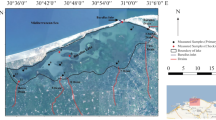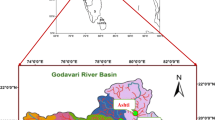Abstract
This study aims to apply Moderate Resolution Imaging Spectroradiometer (MODIS Data) to monitor water quality parameters including chlorophyll-a, secchi disk depth, total phosphorus and total nitrogen at Chaohu Lake. In this paper, multivariate regression analysis, Back Propagation neural networks (BPs), Radial Basis Function neural networks (RBFs) and Genetic Algorithms-Back Propagation (GA-BP) were applied to investigate the relationships between water quality parameters and the MODIS bands combinations. The study results indicated that a simple, efficient and acceptable model could be established through multivariate regression analysis, but the model precision was relatively low. In comparison, BPs, RBFs and GA-BP were significantly advantageous in terms of sufficient utilization of spectra information and model reliance. The relative errors of BPs, RBFs and GA-BP were below 35%. Based on method comparison, it can be concluded that GA-BP is more suitable for simulation and prediction of water quality parameters by applying genetic algorithm to optimize the weight value of BP network. This study demonstrates that MODIS data can be applied for monitoring some of the water quality parameters of large inland lakes.
Similar content being viewed by others
References
American Public Health Association (APHA) (1985). Standard methods for the examination of water and wastewater. Washington, DC: American Public Health Association.
Baban, S. J. (1993). Detecting water quality parameters in the Norfolk Broads, UK, using Landsat imagery. International Journal of Remote Sensing, 14, 1247–1267.
Brivio, P. A., Giardino, C., & Zilioli, E. (2001). Determination of chlorophyll concentration changes in Lake Garda using an image-based radiative transfer code for Landsat TM images. International Journal of Remote Sensing, 22, 487–502.
Chau, K. W. (2006). A review on integration of artificial intelligence into water quality modeling. Marine Pollution Bulletin, 52(7), 726–733.
Chen, T., & Chen, H. (1995). Approximation capability to functions of several variables nonlinear functions and operator by radial basis function neural network. IEEE Transactions on Neural Networks, 6, 904–910.
Dekker, A. G., & Peters, S. W. (1993). The use of the Thematic Mapper for the analysis of eutrophic lakes: a case study in the Netherlands. International Journal of Remote Sensing, 14, 799–821.
Dong, M. L., & Huang, S. W. (2003). Application of RBF neural network in water quality assessment. Environmental Science and Technology, 26, 23–25 (in Chinese).
George, D. G. (1997). The airborne remote sensing of phytoplankton chlorophyll in the lakes and tarns of the English Lakes District. International Journal of Remote Sensing, 18, 1961–1975.
Han, M., & Xi, J. H. (2004). Efficient clustering of radial basis perceptron neural network for pattern recognition. Pattern Recognition, 37(10), 2059–2067.
Harma, P., Vepsalainen, J., Hannonen, T., Pyhalahti, T., Kamari, J., Kallio, K., et al. (2001). Detection of water quality using simulated satellite data and semi-empirical algorithms in Finland. The Science of the Total Environment, 268, 107–121.
Homik, K., Stinchcombe, M., & White, H. (1989). Multi-layer feed forward networks are universal approximators. Neural Networks, 2, 359–366.
Kuang, C. (1999). Water color remote sensing theoretical model. Ph.D. Thesis, Tsinghua University, 15–86 (in Chinese).
Lathrop, R. G., & Lillesand, T. M. (1986). Use of Thematic Mapper data to assess water quality in Green Bay and central Lake Michigan. Photogrammetric Engineering and Remote Sensing, 52, 671–680.
Letelier, R. M., & Abbott, M. R. (1996). An analysis of chlorophyll fluorescence algorithms for the moderate resolution imaging spectrometer (MODIS). Remote Sensing of Environment, 58, 215–223.
Liu, Y. S., Islam, M. A., & Gao, J. (2003). Quantification of shallow water quality parameters by means of remote sensing. Progress in Physical Geography, 27(1), 24–43.
Los, S. O., North, P. R. J., Grey, W. M. F., & Barnsley, M. J. (2005). A method to convert AVHRR Normalized Difference Vegetation Index time series to a standard viewing and illumination geometry. Remote Sensing of Environment, 99(4), 400–411.
Michalewicz, Z. (1999). Genetic Algorithms + Data Structures = Evolution Programs. New York: Springer.
Miller, R. L., & McKee, B. A. (2004). Using MODIS Terra 250 m imagery to map concentrations of total suspended matter in coastal waters. Remote Sensing of Environment, 93, 259–266.
Niculescu, S. P. (2003). Artificial neural networks and genetic algorithms in QSAR. Journal of Molecular Structure, Theochem, 622, 71–83.
Pal, S. R., & Mohanty, P. K. (2002). Use of IRS-1B data for change detection in water quality and vegetation of Chilka lagoon, east coast of India. International Journal of Remote Sensing, 23, 1027–1042.
Singh, R., & Srivastava, L. (2007). Line flow contingency selection and ranking using cascade neural network. Neurocomputing, 70(16–18), 2645–2650.
Wen, S. C., Luo, F., & Fu, L. X. (2001). Application of neural network based on genetic algorithm—a review. Automation & Instrument, 6, 1–4 (in Chinese).
Xia, D. C., & Xu, T. (2004). Artificial intelligence technique and methodology. Wuhan: Hua Zhong University of Science and Technology Press (in Chinese).
Xu, M. Q., Cao, H., Xie, P., Deng, D. G., Feng, W. S., & Xu, J. (2005). The temporal and spatial distribution, composition and abundance of Protozoa in Chaohu Lake, China: Relationship with eutrophication. European Journal of Protistology, 41, 183–192.
Yang, J. Q., & Luo, X. X. (2001). Application of RBF neural network in groundwater predication. Hydrology, 21, 1 – 3 (in Chinese).
Yang, Y. P., Wang, Q., Wang, W. J., & Gao, S. P. (2004). Application and advances of remote sensing techniques in determining water quality. Geography and Geo-information Science, 20, 6–12 (in Chinese).
Yin, C., Lan, Z., Zhao, M., & Bernhardt, H. (1992). Determination of phosphorus concentration threshold for algal growth in eurtrophic Chaohu Lake, China. Journal of Environmental Science and Health Part A—Environmental Science and Engineering & Toxic and Hazardous Substance Control, A27, 433–443.
Zhang, Y. Z., Pulliainen, J., Koponen, S., & Hallikainen, M. (2002). Application of an empirical neural network to surface water quality estimation in the Gulf of Finland using combined optical data and microwave data. Remote Sensing of Environment, 81, 327–336.
Zhang, Y. Z., Pulliainen, J., Koponen, S., & Hallikainen, M. (2003). Water quality retrievals from combined Landsat TM data and ERS-2 SAR data in the Gulf Finland. IEEE Transactions on Geoscience and Remote Sensing, 41, 622–629.
Zhang, J., Wang, J. M., & Guo, N. (2004). Atmospheric correction for EOS-MODIS data using 6s model. Applied Meteorology, 15, 651 – 657 (in Chinese).
Zou, R., Lung, W. S., & Wu, J. (2007). An adaptive neural network embedded genetic algorithm approach for inverse water quality modeling. Water Resources Research, 43(8): Art. No. W08427
Author information
Authors and Affiliations
Corresponding author
Rights and permissions
About this article
Cite this article
Wu, M., Zhang, W., Wang, X. et al. Application of MODIS satellite data in monitoring water quality parameters of Chaohu Lake in China. Environ Monit Assess 148, 255–264 (2009). https://doi.org/10.1007/s10661-008-0156-2
Received:
Accepted:
Published:
Issue Date:
DOI: https://doi.org/10.1007/s10661-008-0156-2




